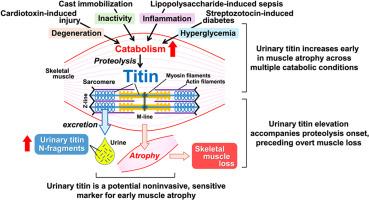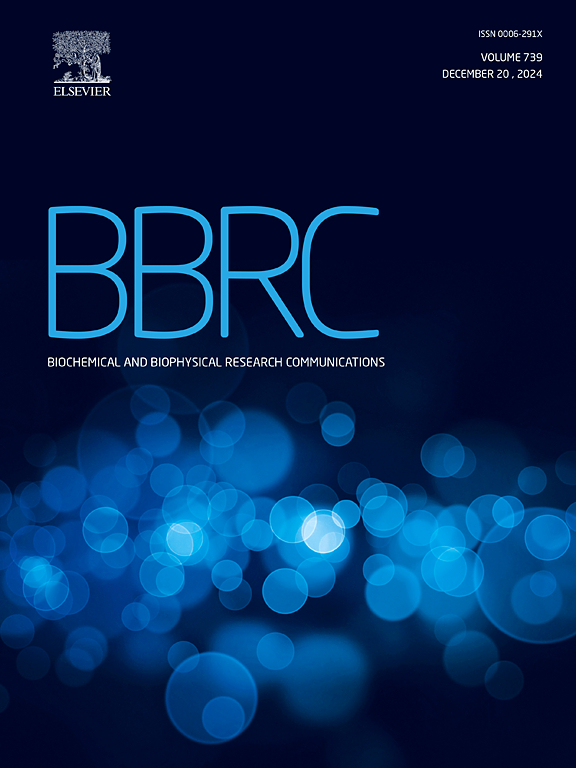Urinary titin as an early biomarker of skeletal muscle proteolysis and atrophy in various catabolic conditions
IF 2.2
3区 生物学
Q3 BIOCHEMISTRY & MOLECULAR BIOLOGY
Biochemical and biophysical research communications
Pub Date : 2024-10-28
DOI:10.1016/j.bbrc.2024.150918
引用次数: 0
Abstract
Skeletal muscle atrophy impairs quality of life and increases the risk of disease, but current methods for assessment of muscle mass have several limitations. We here investigated the urinary concentration of a fragment of the muscle protein titin as a potential biomarker for the early detection of skeletal muscle atrophy. Four mouse models with different atrophy pathways were studied: those of cardiotoxin-induced acute muscle injury, cast-induced muscle immobilization, lipopolysaccharide-induced sepsis, and streptozotocin-induced diabetes. In all four models, urinary titin levels increased early, concurrent with or preceding upregulation of the atrophy-related genes for atrogin-1 and MuRF-1. The increase in the urinary titin concentration was thus associated with initial muscle damage and the onset of proteolysis, rather than with late-stage muscle wasting. Our findings suggest that urinary titin is a promising biomarker for detection of the onset of skeletal muscle catabolism and prediction of the subsequent development of atrophy in different catabolic states. Noninvasive measurement of urinary titin may therefore allow the earlier detection of skeletal muscle proteolysis compared with conventional techniques.

尿液中的 titin 是在各种分解代谢条件下骨骼肌蛋白分解和萎缩的早期生物标志物。
骨骼肌萎缩会影响生活质量并增加患病风险,但目前评估肌肉质量的方法存在一些局限性。我们在此研究了尿液中肌肉蛋白 titin 片段的浓度,以此作为早期检测骨骼肌萎缩的潜在生物标志物。我们研究了四种不同萎缩途径的小鼠模型:心脏毒素诱导的急性肌肉损伤模型、石膏诱导的肌肉固定模型、脂多糖诱导的败血症模型和链脲佐菌素诱导的糖尿病模型。在所有四种模型中,尿液中的钛蛋白水平都在早期增加,与萎缩相关基因 atrogin-1 和 MuRF-1 的上调同时或先于上调。因此,尿液中 titin 浓度的增加与最初的肌肉损伤和蛋白质分解的开始有关,而不是与后期的肌肉萎缩有关。我们的研究结果表明,尿液中的 titin 是一种很有前途的生物标记物,可用于检测骨骼肌分解代谢的开始以及预测不同分解代谢状态下肌肉萎缩的后续发展。因此,与传统技术相比,尿液中 titin 的无创测量可更早地检测骨骼肌蛋白分解。
本文章由计算机程序翻译,如有差异,请以英文原文为准。
求助全文
约1分钟内获得全文
求助全文
来源期刊
CiteScore
6.10
自引率
0.00%
发文量
1400
审稿时长
14 days
期刊介绍:
Biochemical and Biophysical Research Communications is the premier international journal devoted to the very rapid dissemination of timely and significant experimental results in diverse fields of biological research. The development of the "Breakthroughs and Views" section brings the minireview format to the journal, and issues often contain collections of special interest manuscripts. BBRC is published weekly (52 issues/year).Research Areas now include: Biochemistry; biophysics; cell biology; developmental biology; immunology
; molecular biology; neurobiology; plant biology and proteomics

 求助内容:
求助内容: 应助结果提醒方式:
应助结果提醒方式:


